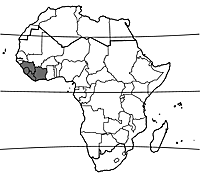Dactyladenia scabrifolia (PROTA)
Introduction |
| General importance | |
| Geographic coverage Africa | |
| Geographic coverage World | |
| Cereal / pulse | |
| Medicinal | |
| Timber | |
Dactyladenia scabrifolia (Hua) Prance & F.White
- Protologue: Brittonia 31: 486 (1979).
- Family: Chrysobalanaceae
Synonyms
- Acioa scabrifolia Hua (1897).
Origin and geographic distribution
Dactyladenia scabrifolia occurs from Guinea to Côte d’Ivoire.
Uses
The wood is locally used for construction, planks and utensils such as rice pestles and mortars. It produces excellent charcoal. A leaf decoction is taken to treat dysentery. The seed is reportedly edible.
Properties
The heartwood is pale brown to reddish brown, sometimes with narrow darker streaks, and not distinctly demarcated from the paler sapwood. The texture is moderately coarse. The wood is fairly heavy, hard and moderately durable.
Description
- Small to medium-sized tree up to 20(–27) m tall; bole usually straight, slightly fluted, up to 50 cm in diameter, without buttresses; bark surface scaly, grey to pale brown, inner bark hard, granular, pale brown to reddish, with clear exudate; crown fairly dense, heavily branched with often drooping branches; twigs glabrous, with pale lenticels.
- Leaves alternate, simple and entire; stipules linear, c. 4 mm long, persistent; petiole 3–5 mm long; blade elliptical to oblong, 6–13(–15) cm × 2.5–5.5 cm, cuneate at base, acuminate at apex, leathery, glabrous, upper surface rough to the touch, with a few glands near base of lower surface, pinnately veined with 4–8 pairs of lateral veins.
- Inflorescence a terminal or axillary raceme 6–10 cm long, slightly hairy.
- Flowers bisexual, zygomorphic, 5-merous, greenish white to pinkish; pedicel 6–14 mm long; receptacle tube narrowly obconical, 4–8 mm long, glabrous; sepals 4–6 mm long; petals 4–6 mm long, caducous; stamens c. 20, fused, 1.5–2.5 cm long; ovary superior, inserted at mouth of receptacle tube, 1-celled, style slightly longer than stamens, slightly 3-lobed at apex.
- Fruit an ovoid drupe 4–5 cm × 2–3 cm, smooth and glabrous, 1-seeded.
- Seedling with epigeal germination.
Other botanical information
In Sierra Leone flowering trees of Dactyladenia scabrifolia have been recorded throughout the year; fruits are most commonly found in August–September.
Dactyladenia comprises about 30 species and is confined to West and Central Africa. Dactyladenia scabrifolia is closely related to Dactyladenia barteri (Hook.f. ex Oliv.) Prance & F.White, which has some reputation as a fallow crop in Nigeria, but the latter species has a hairy receptacle tube and more smooth leaves.
Ecology
Dactyladenia scabrifolia is usually an understorey tree of primary and old secondary rainforest, but also occurs in riverine forest and in abandoned farmland. It is found up to 1100 m altitude in Mount Nimba. It is locally abundant.
Management
Dactyladenia scabrifolia has been considered a weed in managed forest, and trees have been poisoned.
Genetic resources
Dactyladenia scabrifolia is locally abundant in different types of forest and does not seem to be under threat of genetic erosion. However, many other Dactyladenia spp. seem to be uncommon or rare.
Prospects
Trees of Dactyladenia scabrifolia are usually too small to be of importance for their timber. Very little is known about this species, but research could be worthwhile in the light of the good prospects of the related Dactyladenia barteri in agroforestry systems and in fuelwood plantations managed by coppicing.
Major references
- Burkill, H.M., 1985. The useful plants of West Tropical Africa. 2nd Edition. Volume 1, Families A–D. Royal Botanic Gardens, Kew, Richmond, United Kingdom. 960 pp.
- Lapido, D.O. & Kang, B.T., 2002. Dactyladenia barteri (Hook.f. ex Oliv.) Prance & F.White. In: Oyen, L.P.A. & Lemmens, R.H.M.J. (Editors). Plant Resources of Tropical Africa. Precursor. PROTA Programme, Wageningen, the Netherlands. pp. 64–66.
- Prance, G.T. & Sothers, C.A., 2003. Chrysobalanaceae 2: Acioa to Magnistipula. Species Plantarum: Flora of the World. Part 10. Australian Biological Resources Study, Canberra, Australia. 268 pp.
- Savill, P.S. & Fox, J.E.D., 1967. Trees of Sierra Leone. Forest Department, Freetown, Sierra Leone. 316 pp.
Other references
- Aubréville, A., 1959. La flore forestière de la Côte d’Ivoire. Deuxième édition révisée. Tome premier. Publication No 15. Centre Technique Forestier Tropical, Nogent-sur-Marne, France. 369 pp.
- Hawthorne, W. & Jongkind, C., 2006. Woody plants of western African forests: a guide to the forest trees, shrubs and lianes from Senegal to Ghana. Kew Publishing, Royal Botanic Gardens, Kew, United Kingdom. 1023 pp.
- Irvine, F.R., 1961. Woody plants of Ghana, with special reference to their uses. Oxford University Press, London, United Kingdom. 868 pp.
- Kryn, J.M. & Fobes, E.W., 1959. The woods of Liberia. Report 2159. USDA Forest Service, Forest Products Laboratory, Madison, Wisconsin, United States. 147 pp.
Author(s)
- R.H.M.J. Lemmens, PROTA Network Office Europe, Wageningen University, P.O. Box 341, 6700 AH Wageningen, Netherlands
Correct citation of this article
Lemmens, R.H.M.J., 2010. Dactyladenia scabrifolia (Hua) Prance & F.White. [Internet] Record from PROTA4U. Lemmens, R.H.M.J., Louppe, D. & Oteng-Amoako, A.A. (Editors). PROTA (Plant Resources of Tropical Africa / Ressources végétales de l’Afrique tropicale), Wageningen, Netherlands.
Accessed 17 December 2024.
- See the Prota4U database.

